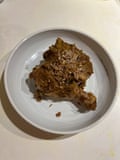
Named the “best food in the world” by not one but two CNN reader polls, this richly flavoured Indonesian dish, originally from Western Sumatra, and also popular in Malaysia and Singapore, is most commonly made with beef. That’s not to say that the chicken version is second best, however – and, as Mandy Yin, chef and proprietor of London’s Sambal Shiok and author of an excellent Malaysian cookbook of the same name, points out, it’s also considerably quicker to make.
This shorter cooking time means that chicken rendang retains more of what the legendary Sumatran-born writer Sri Owen describes as its “luscious, coconut-based sauce”, leading her to suggest, in her classic book Indonesian Regional Food and Cookery, that it might more properly be known as a kalio, a wetter dish than the traditional dry rendang, which was originally a preservation technique as much as a recipe. Though there are many regional variations, fans of the bovine variety will be relieved to hear that the flavours – sweet and spicy – are similar … but you can have this one on the table in an hour and a half, which is, I promise you, a very good thing.
The meat
Every recipe I try starts with a whole chicken (though Owen mentions that a duck can be substituted), jointed. Chef Norman Musa explains in his book Malaysian Food that, “unfortunately, this dish does not work well using chicken breasts, as the dish needs to be simmered for quite a long time, making the chicken go dry and tough”. This doesn’t strike me as unfortunate at all; in fact, like Sharon Wee, author of the book Growing up in a Nonya Kitchen, I prefer just thighs and drumsticks. Why buy expensive chicken breasts just to overcook them?
MasterChef judge Gregg Wallace made headlines around the world in 2018 when he criticised contestant Zaleha Kadir Olpin’s chicken rendang on the basis that “the skin isn’t crispy. It can’t be eaten, but all the sauce is on the skin I can’t eat”.
As Malaysia’s then prime minister, Mohammed Najib Tun Razak, objected: “does anyone eat chicken rendang ‘crispy’?” I see Wallace’s point – despite my best efforts, I also struggle to enjoy the consistency of slow-cooked chicken skin – but the skin keeps the meat juicy as it simmers in a relatively small amount of liquid, so don’t be tempted to remove it; rather, do so before serving or leave it to the diner to decide. Similarly, shred the meat from the bones once cooked, if you must do it all – substituting boneless pieces will rob the dish of a lot of flavour.
The paste
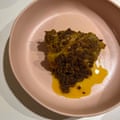
With the exception of Owen’s version, all the rendang recipes I try start with a spice paste. Chillies are mandatory; my testers and I favour the sweeter, richer heat of the dried kind used by Musa and Olpin to Wee’s chilli powder (or, at least, the chilli powder I use in her dish), and the fresh birds eye and red chillies deployed by Malaysian celebrity chef Prof Datuk Redzuawan Ismail, better known as Chef Wan. Owen suggests using sambal oelek, or Indonesian chilli paste, which is a good idea if you happen to have some knocking about and want to save yourself the job of soaking and pounding the chillies.
That said, you’ll need to get out your pestle and mortar (or food processor) for the other ingredients in the paste. Try to find the more intensely sweet red Asian shallots, rather than the larger round or banana varieties. Everyone balances this sweetness with garlic, with Musa using onion as well, though, because my testers can’t identify it, I’m going to stick with shallots.
Their warmth is echoed in the ginger, while the very similar-looking galangal has a citrussy, peppery, pine-fresh perfume that works well with the near ubiquitous lemongrass. A little turmeric powder brings bitterness and colour (substitute fresh turmeric root, if you can find it) – Wan also uses ground coriander, cumin and fennel, but my testers vote for the lighter, more perfumed notes of Musa and Olpin’s recipes.
Olpin looses her spice paste with coconut milk, which makes blending easier, and enriches it with the magnificently oily candlenut; if you like the sound of a creamier, subtly nutty finish, put a couple in your paste (you should be able to find them wherever you buy your galangal).
She also allows the oil to separate from the paste twice – this is an indicator that the water has evaporated and the spices have properly infused – giving her dish “a wonderful flavour”. Musa, who calls his mother’s recipe “the lazy way of doing rendang as you put in all the ingredients in one go”, skips this initial frying stage, as do Owen and Wan, while Wee fries the paste just “until fragrant”. The important thing is to make sure you don’t get any raw notes, and the sight of the oil beading on top is a helpful sign of this.
The sauce

Once the base is prepared, it’s time to dilute it with coconut milk. Musa and Owen also put in both tamarind juice, for acidity (Olpin replaces it with a slice of asam gelugor, an extremely sour fruit, that can be bought dried online), and bruised lemongrass, for extra flavour, which I will be using in the absence of Olpin, Wan and Owen’s turmeric leaves, which apparently impart a “lemony, spicy flavour” that’s impossible to replicate. (Musa, who is similarly unable to get hold of them, uses makrut lime leaves instead, though, like Wan, I’m going to save these for the garnish.)
Wee, whose recipe comes from her mother, who in turn got it from the chefs at the “old Jubilee restaurant” on Singapore’s Arab Street, also includes tomatoes, giving her sauce a more savoury depth of flavour, if that appeals. My testers, however, prefer the sweetness of Musa, Olpin and Wan’s versions, sweetened with sugar and toasted coconut to amplify the flavour of the shallots and ginger. This is easy to make with desiccated strands, and also adds texture to the finished dish, helping the sauce to cling to the meat in a satisfying fashion.
As important as what you put in the pan is how you cook it, and this time you must simmer it until the oil separates, indicating the spices are cooked (indeed, Owen lets the sauce bubble away for an hour before even adding the meat). This is not a very wet dish, so choose your pan carefully, because making it in too wide a vessel will mean the liquid evaporates before the meat is cooked through.
Owen directs the cook to simmer the coconut milk until it becomes oil “with the blondo, or sediment, well blended with the spices”, then to “go on cooking, stirring often, until all the oil has been absorbed by the meat and sediment”. For all my stirring, the oil refuses to be reabsorbed, so in the end I give up and the dish is still incredibly good, the meat juicy, the paste thick and aromatic, as it should be. This is not what might be termed, in the UK at least, a curry.
To finish
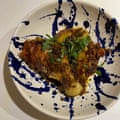
Wan serves the rendang topped with chillies and makrut lime leaves, a combination that looks pretty and tastes gloriously fragrant (though you might wish to skip the chillies if the rendang is already hot enough for your liking), while Musa recommends crispy fried shallots, Wee coriander and mint leaves, and Olpin rice and other dishes; Owen suggests “any green vegetables” as a possible accompaniment to “plenty of rice”. And you’ll certainly need something to help mop up that deliciously thick sauce.
Perfect chicken rendang
Prep 20 min
Cook 1 hr 10 min
Serves 4-6
15-20 dried chillies, seeds removed if you prefer less heat
Salt
100g shallots, preferably small red Asian ones (about 8)
4 garlic cloves
50g root ginger
40g galangal root
4 lemongrass stalks
½ tsp turmeric powder, or ½ tbsp peeled and minced turmeric root
3 tbsp neutral oil
50g desiccated coconut, or 100g fresh grated coconut
4 bone-in chicken thighs and 4 bone-in chicken drumsticks, or 4 whole legs, or 1 chicken, jointed
500ml coconut milk
2 tbsp tamarind water
2 tbsp palm sugar, or light brown sugar (optional)
Makrut lime leaves and fresh red chilli, to serve
Soak the chillies in boiling water for 10-15 minutes, until soft.
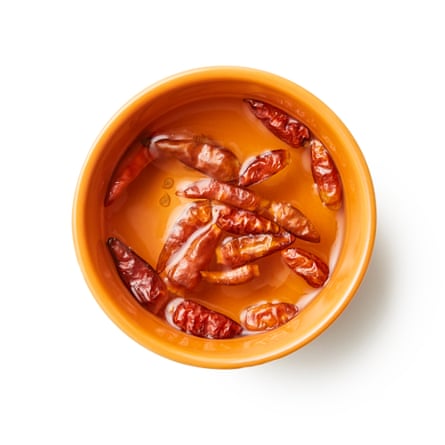
Drain the chillies, then put them in a mortar or small food processor, add a little salt, then pound to a paste.
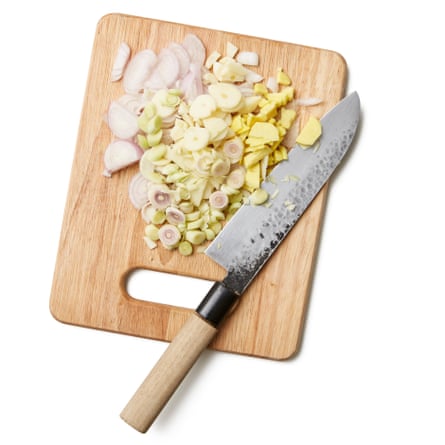
Peel and slice the shallots, garlic, ginger and galangal, and peel and finely chop three of the lemongrass stalks.
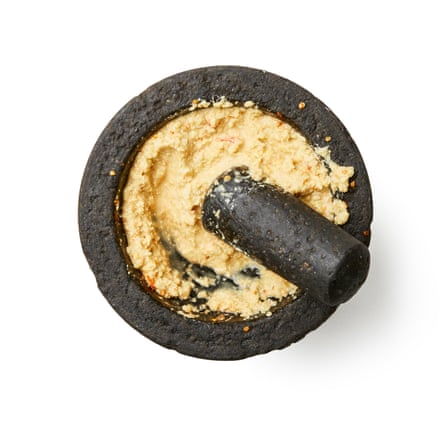
Add all these to the chillies with the turmeric, a good pinch of salt and 75ml of the coconut milk, and pound to a paste.
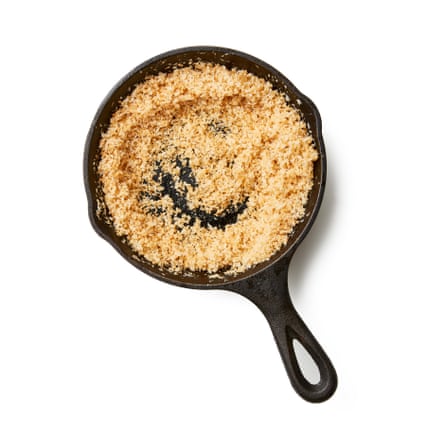
If using desiccated coconut, put a tablespoon of the oil in a frying pan on a medium heat, then fry the coconut, stirring, until deep golden brown; if using fresh grated coconut, do the same, but without the oil. Pound the fried coconut to a paste while it’s still warm.
Pour the remaining oil into a pan just wide enough to hold the chicken in a single layer and put it on a medium-low heat. Scrape the spice paste into the pan and fry, stirring regularly, until fragrant, oily and audibly frying, rather than steaming.
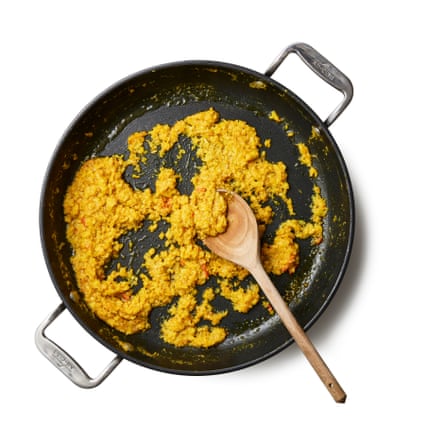
Stir in the remaining coconut milk, tamarind water and sugar, then add the chicken to the pot, pushing it down into the sauce.
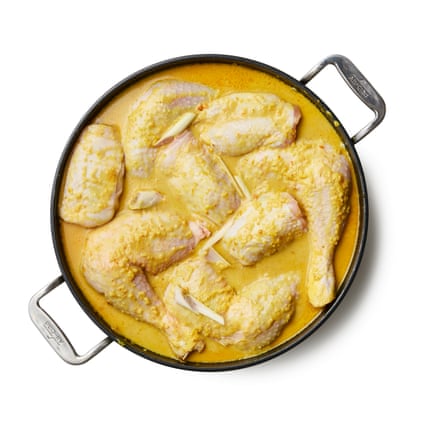
Add the remaining lemongrass stalk, bruising it well first, then bring to a simmer. Turn down the heat and leave to cook, turning the chicken occasionally, so it cooks evenly, and stirring regularly to make sure the sauce doesn’t burn, for about an hour, until the oil pools in orange puddles on top and the sauce is thick, dark and paste-like.
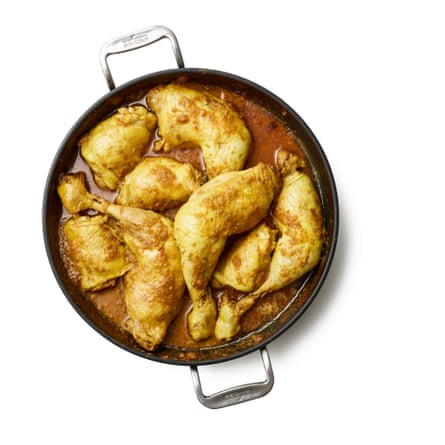
Stir in the toasted coconut and adjust the seasoning, if necessary. Scatter with shredded lime leaves and chillies to serve.
-
Can chicken rendang ever be a patch on the beef version? If so, what’s the secret to a really great one, and what do you like to eat with it? And if not, which beef rendang recipe would you recommend?



